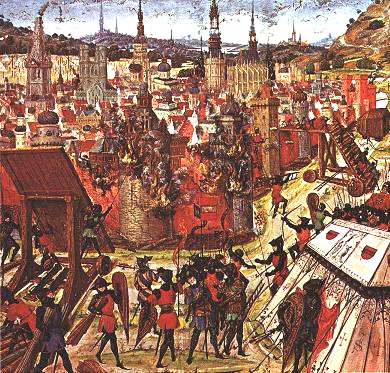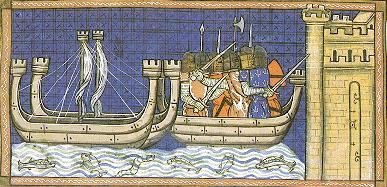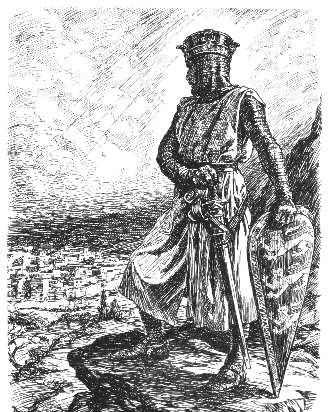Crusades
The Crusades were a series of several military campaigns — usually sanctioned by the Papacy— that took place during the 11th through 13th centuries. Originally, they were Roman Catholic endeavors to re-capture the Holy Land from the Muslims, but some were directed against other Europeans, such as the Fourth Crusade against Constantinople, the Albigensian Crusade against the Cathars of southern France and the Northern Crusades.
The origins of the crusades lie in Western developments earlier in the Middle Ages, as well as the deteriorating situation of the Byzantine Empire. The breakdown of the Carolingian Empire in the later 9th century, combined with the relative stabilization of local European borders after the Christianization of the Vikings, Slavs, and Magyars, meant that there was an entire class of warriors who now had very little to do but fight among themselves and terrorize the peasant population. The Church tried to stem this violence with the Peace and Truce of God movements, forbidding violence against certain people at certain times of the year. This was somewhat successful, but trained warriors always sought an outlet for their violence. A plea for help from the Byzantine Emperor Alexius I in opposing Muslim attacks thus fell on ready ears.
One later outlet was the Reconquista in Spain, which at times occupied Spanish knights and some mercenaries from elsewhere in Europe in the fight against the Islamic Moors. In 1063, Pope Alexander II had given papal blessing to Spanish Christians in their wars against the Muslims, granting both a papal standard (the vexillum sancti Petri) and an indulgence to those who were killed in battle. Even today Spanish Catholics are allowed to substitute Friday abstinence with prayer or alms (except during Lent).
 Fall of Jerusalem during the First Crusade |
The Crusades were in part an outlet for an intense religious piety which rose up in the late 11th century among the lay public. This was due in part to the Investiture Controversy, which had started around 1075 and was still on-going during the First Crusade. Christendom had been greatly affected by the Investiture Controversy, as both sides tried to marshal public opinion in their favor, people became personally engaged in a dramatic religious controversy. The result was an awakening of intense Christian piety and public interest in religious affairs, which would manifest in the overwhelming popular support for the First Crusade, and the religious vitality of the 12th century.
This background in the Christian West must be matched with that in the Muslim East. Muslim presence in the Holy Land goes back to the initial Arab conquest of Palestine in the 7th century. This did not interfere much with pilgrimage to Christian holy sites or the security of monasteries and Christian communities in the Holy Land of Christendom, and western Europeans were not much concerned with the loss of far-away Jerusalem when, in the ensuing decades and centuries, they were themselves faced with invasions by Muslims and other hostile non-Christians such as the Vikings and Magyars. However, the Muslim armies' successes were putting strong pressure on the Eastern Orthodox Byzantine Empire.
A turning point in western attitudes towards the east came in the year 1009, when the Fatimid caliph of Cairo, al-Hakim bi-Amr Allah, had the Church of the Holy Sepulchre in Jerusalem destroyed. His successor permitted the Byzantine Empire to rebuild it under stringent circumstances, and pilgrimage was again permitted, but many stories began to be circulated in the West about the cruelty of Muslims toward Christian pilgrims; these rumors then played an important role in the development of the crusades later in the century.
The trigger for the First Crusade was Emperor Alexius I's appeal to Pope Urban II for mercenaries to help him resist Muslim advances into territory of the Byzantine Empire. Although the East-West Schism was brewing between the Catholic Western church and the Greek Orthodox Eastern church, Alexius I expected some help from a fellow Christian. However, the response was much larger, and less helpful, than Alexius I desired, as the Pope called for a large invasion force to not merely defend the Byzantine Empire but also retake Jerusalem.
When the First Crusade was preached in 1095, the Christian princes of northern Iberia had been fighting their way out of the mountains of Galicia and Asturias, the Basque country and Navarre, with increasing success, for about a hundred years. The fall of Moorish Toledo to the Kingdom of León in 1085 was a major victory, but the turning points of the Reconquista still lay in the future. The disunity of the Muslim emirs was an essential factor, and the Christians, whose wives remained safely behind, were hard to beat: they knew nothing except fighting, they had no gardens and libraries to defend, and they worked their way forward through alien territory populated by infidels, where the Christian fighters felt they could afford to wreak havoc. All these factors were soon to be replayed in the fighting grounds of the East. Spanish historians have traditionally seen the Reconquista as the molding force in the Castilian character, with its sense that the highest good was to die fighting for the cause of the right deity, in a Christian jihad. An ascetic religious fanaticism enforced by a military aristocracy became the dominant social value.

While the Reconquista was the most prominent example of Christian war against Muslim conquests, it is not the only such example. The Norman adventurer Robert Guiscard had conquered the "toe of Italy," Calabria, in 1057 and was holding what had traditionally been Byzantine territory against the Muslims of Sicily. The maritime states of Pisa, Genoa and Catalonia were all actively fighting Islamic strongholds in Majorca and Sardinia, freeing the coasts of Italy and Catalonia from Muslim raids. Much earlier, of course, the Christian homelands of Syria, Lebanon, Israel, Egypt, and so on had been conquered by Muslim armies. This long history of losing territories to a religious enemy, as well as a powerful pincer movement on all of Western Europe, created a powerful motive to respond to Byzantine emperor Alexius I's call for holy war to defend Christendom, and to recapture the lost lands, starting at the most important one of all, Jerusalem itself.
The papacy of Pope Gregory VII had struggled with reservations about the doctrinal validity of a holy war and the shedding of blood for the Lord and had resolved the question in favor of justified violence. Actions against Arians and other heretics offered historical precedents in a society where violence against unbelievers, and indeed against other Christians, was acceptable and common. Saint Augustine of Hippo, Gregory's intellectual model, had justified the use of force in the service of Christ in The City of God, and a Christian "just war" might enhance the wider standing of an aggressively ambitious leader of Europe, as Gregory saw himself. The northerners would be cemented to Rome and their troublesome knights could see the only kind of action that suited them. Previous attempts by the church to stem such violence, such as the concept of the "Peace of God", were not as successful as hoped. To the south of Rome, Normans were showing how such energies might be unleashed against both Arabs (in Sicily) and Byzantines (on the mainland). A Latin hegemony in the Levant would provide leverage in resolving the Papacy's claims of supremacy over the Patriarch of Constantinople, which had resulted in the Great Schism of 1054, a rift that might yet be resolved through the force of Frankish arms.
In the Byzantine homelands the Eastern Emperor's weakness was revealed by the disastrous defeat at the Battle of Manzikert in 1071, which reduced the Empire's Asian territory to a region in western Anatolia and around Constantinople. A sure sign of Byzantine desperation was the appeal of Alexius I Comnenus to his enemy the Pope for aid. But Gregory was occupied with the Investiture Controversy and could not call on the German emperor and the crusade never took shape. For Gregory's more moderate successor Pope Urban II, a crusade would serve to reunite Christendom, bolster the Papacy, and perhaps bring the East under his control. The disaffected Germans and the Normans were not to be counted on, but the heart and backbone of a crusade could be found in Urban's own homeland among the northern French.
On a popular level, the first crusades unleashed an unprecedented wave of impassioned, personally felt pious fury that was expressed in the massacres of Jews that accompanied the movement of mobs through Europe, and the violent treatment of "schismatic" Orthodox Christians of the east. This first phase of the Crusading movement culminated and largely spent itself in the rampages of the sack of Constantinople in 1204.
The 13th century crusades never expressed such a popular fever, and after Acre fell for the last time in 1291, and after the extermination of the Occitan Cathars in the Albigensian Crusade, the crusading ideal became devalued by Papal justifications of political and territorial aggressions within Catholic Europe.
The last crusading order of knights to hold territory were the Knights Hospitaller. After the final fall of Acre they took control of the island of Rhodes, and in the sixteenth century were driven to Malta. These last crusaders were finally unseated by Napoleon in 1798.
A traditional numbering scheme for the crusades gives us nine during the 11th to 13th centuries, as well as other smaller crusades that are mostly contemporaneous and unnumbered. There were frequent "minor" crusades throughout this period, not only in Palestine but also in Spain and central Europe, against not only Muslims, but also Christian heretics and personal enemies of the Papacy or other powerful monarchs. Such "crusades" continued into the 16th century, until the Renaissance and Reformation when the political and religious climate of Europe was significantly different than that of the Middle Ages. The following is a listing of the "major" crusades.
After Byzantine emperor Alexius I called for help with defending his empire against the Seljuk Turks, in 1095 Pope Urban II called upon all Christians to join a war against the Turks, a war which would count as full penance. Crusader armies marched to Jerusalem, sacking several cities on their way. In 1099, they took Jerusalem and massacred the population. As a result of the First Crusade, several small Crusader states were created, notably the Kingdom of Jerusalem. Following this crusade there was a second, unsuccessful wave of crusaders.
After a period of relative peace, in which Christians and Muslims co-existed in the Holy Land, Bernard of Clairvaux called for a new crusade when the town of Edessa was conquered by the Turks. French and German armies marched to Asia Minor in 1147, but failed to accomplish any major successes, and indeed endangered the survival of the Crusader states with a foolish attack on Damascus. In 1149, both leaders had returned to their countries without any result.
In 1187, Saladin recaptured Jerusalem. Pope Gregory VIII preached a crusade, which was led by several of Europe's most important leaders: Philip II of France, Richard I of England and Frederick I, Holy Roman Emperor. Frederick drowned in Cilicia in 1190, leaving an unstable alliance between the English and the French. Philip left in 1191 after the Crusaders had recaptured Acre from the Muslims. The Crusader army headed down the coast of the Mediterranean Sea. Saladin would attack the Crusaders, but the Crusaders would not respond. They defeated the Muslims near Arsuf and were in sight of Jerusalem. But, Saladin poisoned the wells and destroyed the crops. Richard left the following year after establishing a truce with Saladin. On Richard's way home his ship was wrecked leading him to Austria. In Austria his enemy Duke Leopold captured him and Richard was held for a king's ransom.
The Fourth Crusade was initiated by Pope Innocent III in 1202, with the intention of invading the Holy Land through Egypt. The Venetians gained control of this crusade and diverted it to Constantinople where they attempted to place a Byzantine exile on the throne. After a series of misunderstandings and outbreaks of violence, the city was sacked in 1204. The popular spirit of the movement was now dead, and the succeeding crusades are to be explained rather as arising from the Papacy's struggle to divert the military energies of the European nations toward Syria.
The Albigensian Crusade was launched in 1209 to eliminate the "heretical" Cathars of southern France. It was a decades-long struggle that had as much to do with the concerns of northern France to extend its control southwards as it did with heresy. In the end, both the Cathars and the independence of southern France were exterminated.

The Children's Crusade is a possibly fictitious or misinterpreted crusade of 1212. The story is that an outburst of the old popular enthusiasm led a gathering of children in France and Germany, which Pope Innocent III interpreted as a reproof from heaven to their unworthy elders. None of the children actually reached the Holy Land, being sold as slaves or dying of hunger during the journey.
By processions, prayers, and preaching, the Church attempted to set another crusade on foot, and the Fourth Council of the Lateran (1215) formulated a plan for the recovery of the Holy Land. A crusading force from Hungary, Austria, and Bavaria achieved a remarkable feat in the capture of Damietta in Egypt in 1219, but under the urgent insistence of the papal legate, Pelagius, they proceeded to a foolhardy attack on Cairo, and an inundation of the Nile compelled them to choose between surrender and destruction.
In 1228, Emperor Frederick II set sail from Brindisi for Syria, though laden with the papal excommunication. Through diplomacy he achieved unexpected success, Jerusalem, Nazareth, and Bethlehem being delivered to the Crusaders for a period of ten years. This was the first major crusade not initiated by the Papacy, a trend that was to continue for the rest of the century.
The papal interests represented by the Templars brought on a conflict with Egypt in 1243, and in the following year a Khwarezmian force summoned by the latter stormed Jerusalem. Although this provoked no widespread outrage in Europe as the fall of Jerusalem in 1187 had done, Louis IX of France organized a crusade against Egypt from 1248 to 1254, leaving from the newly constructed port of Aigues-Mortes in southern France. It was a failure and Louis spent much of the crusade living at the court of the Crusader kingdom in Acre. In the midst of this crusade was the first Shepherds' Crusade in 1251.
The eighth Crusade was organized by Louis IX in 1270, again sailing from Aigues-Mortes, initially to come to the aid of the remnants of the Crusader states in Syria. However, the crusade was diverted to Tunis, where Louis spent only two months before dying.
The future Edward I of England undertook another expedition in 1271, after having accompanied Louis on the Eighth Crusade. He accomplished very little in Syria and retired the following year after a truce. With the fall of Antioch (1268), Tripoli (1289), and Acre (1291) the last traces of the Christian occupation of Syria disappeared.
The Crusades in the Baltic Sea area and in Central Europe were efforts by (mostly German) Christians to subjugate and convert the peoples of these areas to Christianity. These Crusades ranged from the 12th century, contemporaneous with the Second Crusade, to the 16th century
Click here to go back to the Middle East Page!
This article is licensed under the GNU Free Documentation License. It uses material from the Wikipedia article "Crusades".